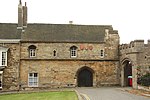Lincoln Cathedral

Lincoln Cathedral, also called Lincoln Minster and formally the Cathedral Church of the Blessed Virgin Mary of Lincoln, is a Church of England cathedral in Lincoln, England. It is the seat of the bishop of Lincoln and thus is the mother church for the diocese of Lincoln. The cathedral is governed by its dean and chapter, and is a grade I listed building. The earliest parts of the current building date to 1072, when Bishop Remigius de Fécamp moved his seat from Dorchester on Thames to Lincoln. The building was completed in 1092, but severely damaged in an earthquake in 1185. It was rebuilt over the following centuries in the Gothic style. The cathedral became the tallest building in the world upon the completion of its 160-metre-high (525 ft) central spire in 1311. It surpassed the Great Pyramid of Giza, and held the title until the spire collapsed in 1548 and was not rebuilt.The cathedral holds one of the four remaining copies of the original Magna Carta, which is now displayed in Lincoln Castle. It is the fourth largest cathedral in the UK by floor area, at approximately 5,000 m2 (50,000 sq ft), after Liverpool Cathedral, St Paul's Cathedral, and York Minster. It is highly regarded by architectural scholars; the Victorian writer John Ruskin declared: "I have always held ... that the cathedral of Lincoln is out and out the most precious piece of architecture in the British Isles and roughly speaking worth any two other cathedrals we have."
Excerpt from the Wikipedia article Lincoln Cathedral (License: CC BY-SA 3.0, Authors, Images).Lincoln Cathedral
Minster Yard, Lincoln New Boultham
Geographical coordinates (GPS) Address Website External links Nearby Places Show on map
Geographical coordinates (GPS)
| Latitude | Longitude |
|---|---|
| N 53.234444444444 ° | E -0.53611111111111 ° |
Address
Lincoln Cathedral (Cathedral Church of the Blessed Virgin Mary)
Minster Yard
LN2 1PX Lincoln, New Boultham
England, United Kingdom
Open on Google Maps











